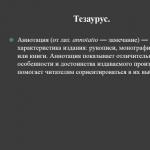The production factor whose impact on the employee can. Industrial (working) environment, its dangers and harmfulness. Dangerous and harmful production factors
Occupational safety is a system for preserving the life and health of employees in the course of their work, including legal, socio-economic, organizational and technical, sanitary and hygienic, medical and preventive, rehabilitation and other measures.
Working conditions - a combination of factors of the working environment and labor process affecting the performance and health of the worker.
A harmful production factor is a production factor, the impact of which on an employee can lead to his illness.
A hazardous production factor is a production factor, the impact of which on an employee can lead to his injury.
Safe working conditions - working conditions under which the impact on workers of harmful and (or) dangerous production factors is excluded or the levels of their impact do not exceed the established standards.
Workplace- the place where the employee must be or where he needs to arrive in connection with his work and which is directly or indirectly under the control of the employer.
Means of individual and collective protection of workers - technical means used to prevent or reduce the impact on workers of harmful and (or) hazardous production factors, as well as to protect against pollution.
The labor protection management system is a complex of interrelated and interacting elements that establish the policy and goals in the field of labor protection for a particular employer and procedures for achieving these goals. The model regulation on the labor protection management system is approved by the federal executive body responsible for the development of state policy and legal regulation in the field of labor, taking into account the opinion of the Russian tripartite commission for the regulation of social and labor relations.
Production activity is a set of actions of workers using the means of labor necessary to transform resources into finished products, including the production and processing of various types of raw materials, construction, and the provision of various types of services.
Occupational safety requirements - state regulatory requirements for labor protection, including labor safety standards, as well as labor protection requirements established by the rules and instructions for labor protection.
State examination of working conditions - assessment of the compliance of the object of examination with state regulatory requirements for labor protection.
Occupational safety standards are rules, procedures, criteria and standards aimed at preserving the life and health of employees in the course of their work and regulating the implementation of socio-economic, organizational, sanitary and hygienic, medical and preventive, rehabilitation measures in the field of labor protection.
Occupational risk - the probability of causing harm to health as a result of exposure to harmful and (or) hazardous production factors in the performance of duties by an employee employment contract or in other cases established by this Code, other federal laws. The procedure for assessing the level of occupational risk is established by the federal executive body responsible for the development of state policy and legal regulation in the sphere of labor, taking into account the opinion of the Russian tripartite commission for the regulation of social and labor relations.
Occupational risk management is a set of interrelated activities that are elements of the labor protection management system and include measures to identify, assess and reduce occupational risk levels.
Commentary on Art. 209 of the Labor Code of the Russian Federation
1. The basic concepts in the field of labor protection given in this article contribute to the correct and uniform application of fundamental norms labor law in protecting the legitimate rights and interests of the parties to the employment contract.
2. When formulating these concepts, the provisions of the relevant international legal acts were taken into account, in particular the ILO Convention No. 155 “On Safety and Health at Work and the Working Environment” (1981), as well as other acts.
Second commentary on Article 209 of the Labor Code
1. Section X (chapters 33 - 36) of the Labor Code of the Russian Federation combines the norms of the labor protection institute. It is one of the most important institutions of labor law, providing safe and healthy working conditions. In the commented article of the Code, the main concepts of this institution are fixed: “labor protection”, “working conditions”, “harmful production factor”, “hazardous production factor”, “safe working conditions”, “workplace”, “means of individual and collective protection of workers ”, “certificate of conformity of work on labor protection (safety certificate)”, “production activity”.
Occupational safety is a system for preserving the life and health of an employee in the course of labor activity, which includes legal, socio-economic, organizational, technical, sanitary and hygienic, medical and preventive, rehabilitation and other measures.
So, labor protection is the creation of healthy and safe working conditions by various means. Depending on the latter, labor protection is distinguished in a broad and narrow sense. In a broad sense, labor protection is a system of measures to preserve the life and health of workers in the course of work, including legal, socio-economic, organizational, technical, sanitary and hygienic, treatment and preventive, rehabilitation and other measures. This concept of protection was enshrined in Art. 1 of the Federal Law "On the basics of labor protection in Russian Federation"of July 17, 1999 (SZ RF. 1999. N 29. Art. 3702) (hereinafter - the Law on Labor Protection) and Art. 209 of the Labor Code of the Russian Federation. It has now expired.
In a narrow sense, labor protection is a set of measures in the following areas: legal, economic, organizational and technical (safety of equipment, means of production), treatment and prevention, etc. Therefore, certain areas of labor protection are studied in the relevant universities. In law schools, the emphasis is on the legal institution of labor protection as a system of legal norms that ensure health and safe working conditions, enshrined in the said Law on labor protection and in chapters 33 - 36, 41, 42 and, as well as in other laws and regulations, in collective agreements and agreements.
But only labor protection in its broadest sense can provide healthy and safe working conditions. If at least some of its components (i.e., the labor protection component in the narrow sense) are not properly ensured, the entire labor protection system is practically not ensured. So, if machines, equipment, tools, machines (technical components) are unsafe for the life and health of workers, accidents are inevitable, industrial injuries, which, by the way, have increased significantly in recent years due to wear and tear of equipment.
If a legal aspect labor protection is violated, the entire labor protection system is also violated. The same happens in case of violation of its socio-economic or medical components. Consequently, comprehensive labor protection will be ensured only when all its components in the broadest sense are observed.
2. Section X of the Labor Code of the Russian Federation in accordance with Art. 37 of the Constitution of the Russian Federation is aimed at preserving the life and health of workers in the process of their work. They fixed the main directions (principles) of the state policy in the field of labor protection, public administration labor protection, the right of workers to labor protection and its guarantees, measures to ensure labor protection. On special rules for labor protection of women, minors and persons with family responsibilities see comments to chapters 41, 42, 57 of the Labor Code of the Russian Federation, as well as the federal law"On Compulsory Social Insurance against Industrial Accidents and Occupational Diseases" dated July 2, 1998
3. Working conditions - a set of factors of the working environment and the labor process that affect the performance and health of the employee. They can be normal, severe, harmful, dangerous to the life and health of workers. These factors of production are a component (constituent) general conditions labor, about which the employee agrees with the employer, i.e. his work time, rest time, including all types of holidays, wages and other conditions.
4. The impact of a harmful production factor can lead to an employee's illness, and an occupational disease at that. For example, in a miner, these are different forms of silicosis, when the lungs are filled with coal dust.
5. Hazardous production factor, affecting the worker, can injure him. It is especially manifested in blasting, the work of firefighters, steeplejacks, divers, etc.
6. Article 209 of the Labor Code of the Russian Federation gives the concept of safe working conditions. These are the conditions under which the impact on the employee of harmful and (or) dangerous production factors is excluded or the level of their impact does not exceed the established standards. Therefore, in ordinary production practice, they are called normal working conditions, as was recorded in the Labor Code.
7. The workplace is the place where the employee performs or is required to perform his/her work in common process labor, which is directly or indirectly under the control of the employer or representatives of his administration, direct supervisors of the work.
8. Personal and collective protective equipment is designed to prevent or reduce the impact on the employee of harmful and (or) dangerous production factors (gas masks, respirators, goggles, masks, etc.), as well as to protect against contamination (overalls, soap and etc.).
9. A safety certificate is a document certifying the compliance of the labor protection work carried out in the organization with the established state regulatory requirements. Each production must have a safety certificate.
New and reconstructed production facilities and means of production cannot be accepted into operation if they do not have a safety certificate issued in the prescribed manner. At operating enterprises, in accordance with the Certification Regulations, an appropriate safety certificate is issued (parts 3 and 4 of article 11 of the Labor Protection Law).
10. The new edition of the commented article has changed the name of the certificate of conformity of work on labor protection (safety certificate). Now it is called the "certificate of compliance of the organization of work on labor protection" and is a document certifying the compliance of the work carried out by the employer on labor protection with state regulatory requirements for labor protection.
11. Art. 209 in new edition introduces such new concepts of the institute of labor protection as:
a) "requirements for labor protection" - state regulatory requirements for labor protection, established by the rules and instructions for labor protection;
b) "state examination of working conditions" - assessment of the compliance of the object of examination with state regulatory requirements for labor protection;
c) "attestation of workplaces in terms of working conditions" - assessment of working conditions at workplaces in order to identify harmful and (or) dangerous production factors and take measures to bring working conditions in line with state regulatory requirements for labor protection.
The federal executive body, which carries out the functions of developing state policy and legal regulation in the field of labor, establishes the procedure for attesting workplaces.
A full explanation on the topic: "a production factor whose impact on an employee can lead to his illness is" from professional lawyer with answers to all your questions.
Harmful production factor - a production factor, the impact of which on an employee can lead to his illness
Means of individual and collective protection of workers - technical means used to prevent or reduce the impact on workers of harmful and (or) dangerous production factors, as well as to protect against pollution. (part eight as amended by Federal Law No. 421-FZ of December 28, 2013)
Harmful can be: Most people work in factories, factories, construction sites.

Each profession is dangerous for humanity in its own way: There is no such activity where there is no risk to human health. Danger is always and everywhere. In pursuit of big money, people try to ignore the risk, in the end it can kill.
Download documents on the topic: Harmful production Harmful, the presence of which is the basis for the regular examination of workers, are divided into 4 independent groups: chemical, biological, physical and factors of the labor process. Within each group, specific harmful ones are listed.
Each has its own requirements for the frequency of the examination (usually once every 1-2 years) and its volume (list of specialist doctors, list of tests and examinations), as well as contraindications to work in the presence of this factor.
3. Safe working conditions are: a) working conditions under which workers are exposed to either only dangerous or only harmful production; b) working conditions under which the impact on workers of harmful and (or) hazardous production factors is excluded or the levels of their impact do not exceed the established standards; c) working conditions under which the mortality of workers exposed to dangerous and (or) harmful production factors does not exceed 70%; d) working conditions under which the mortality of workers exposed to dangerous and (or) harmful production factors does not exceed 50%; e) working conditions under which the mortality of workers exposed to dangerous and (or) harmful factors does not exceed 30%.
Production factor that can lead to injury
Production factor that can lead to injury
"Dangerous and harmful are divided by the nature of the action into the following groups: Obviously, harmful and dangerous radiation by the nature of the action belong to the group -"
A hazardous production factor (HPF) is a production factor, the impact of which on a worker under certain conditions leads to injury or other sudden, sharp deterioration in health.
The production factor whose impact on an employee can lead to his illness is
Note. Depending on the quantitative characteristics (level, concentration, etc.) and the duration of exposure, harmful can become dangerous 3.4 harmful production factor: According to GOST 12.0.002. Harmful - a production factor, the impact of which on a worker under certain conditions leads to illness or a decrease in working capacity.
The production factor whose impact on an employee can lead to his illness is
1. A harmful production factor is:
a) a production factor, the impact of which on an employee can lead to his illness;
b) the impact on the worker can lead to his injury;
c) exposure to a worker may result in illness or injury.
a) exposure to a worker may lead to his illness;
b) the impact of which on the employee may lead to his injury;
c) a production factor, the impact of which on an employee can lead to his illness or injury.
3. Safe working conditions are:
a) working conditions under which workers are exposed to either only dangerous or only harmful production factors;
b) working conditions under which the impact on workers of harmful and (or) hazardous production factors is excluded or the levels of their impact do not exceed the established standards;
c) working conditions under which the mortality of workers exposed to dangerous and (or) harmful production factors does not exceed 70%;
d) working conditions, when the mortality of workers who are affected by dangerous and (or) harmful production factors does not exceed 50%;
e) working conditions under which the mortality of workers affected by dangerous and (or) harmful does not exceed 30%.
b) are binding on legal and individuals when they carry out any kind of activity;
c) are obligatory for execution by legal entities and individuals only when they carry out activities associated with increased danger.
5. Responsibilities for ensuring safe conditions and labor protection in the organization are assigned to:
c) specialized state bodies.
6. Provided by Article 213 Labor Code RF preliminary and periodic medical examinations (examinations) and psychiatric examinations of certain categories of employees are carried out at the expense of funds.
Work in chemical plants is also dangerous for people, because it can develop various ailments. Medical examinations can reveal a decrease in working capacity, hearing impairment. The constant presence of a person at the source of adverse effects leads to an occupational disease. Most often, accidents occur due to physical factors, as well as from electric current. Electrical safety Hazardous production factor is characterized by the following concept - electrical safety. Electric current is a hidden danger because it is difficult to detect in various parts of the equipment. The most dangerous is considered to be above 0.05A, and the safest is up to 0.05A. To prevent damage, work with current should be performed only by a specialist. Based on the rules in back office the electrical wiring must be constantly monitored.
Occupational Safety and Health. harmful and dangerous production factors. part v
Labor protection - basic concepts and explanations
- PART III. PART THREE
- Section X. LABOR SAFETY
- Chapter 33
GENERAL PROVISIONS
Occupational safety is a system for preserving the life and health of workers in the course of their work, including legal, socio-economic, organizational and technical, sanitary and hygienic, medical and preventive, rehabilitation and other measures. Important Working conditions - a set of factors of the working environment and the labor process that affect the performance and health of the employee.
Harmful production factor - a production factor, the impact of which on an employee can lead to his illness.
The production factor of labor. harmful and dangerous production factors
State management of labor protection in the territories of the constituent entities of the Russian Federation is carried out by federal executive authorities and executive authorities of the constituent entities of the Russian Federation in the field of labor protection within their powers. - a system for preserving the life and health of workers in the course of labor activity, including legal, socio-economic, organizational and technical, sanitary and hygienic, medical and preventive, rehabilitation and other measures. Working conditions - a combination of factors of the working environment and the labor process that have impact on worker performance and health.
A production factor whose impact can lead to a disease
The production factor that can lead to injury "dangerous and harmful are divided by the nature of the action into the following groups: Obviously, harmful and dangerous radiation by the nature of the action belong to the group -" A hazardous production factor (HPF) is such a production factor, the impact of which on a worker in certain conditions leads to injury or other sudden, severe deterioration in health. The production factor, the impact of which on an employee can lead to his illness, is biological (pathogenic microorganisms); neuro-emotional (intellectual and emotional stress, shift work, often with a lack of time and in extreme situations); ergonomic (work in a forced position and when operating ergonomically inadequate equipment).
3.
Medical examinations.
Physiological factors This group includes:
- working machines, mechanisms, equipment;
- accumulation of a large amount of dust and gases;
- high or low temperature equipment;
- pressure drops in the working part of the equipment;
- high or low humidity levels;
- air ionization;
- ionizing radiation;
- high voltage in the mains;
- increase in static electricity.
Other types of factors The chemical production factor is toxic, irritating, carcinogenic, mutagenic. They have an effect on reproductive function. The biological production factor is presented in the form of microorganisms and their metabolic products.
There are also psychological factors. It can be physical and neuropsychic overload.
Production factor, the impact of which on an employee can lead to his illness
Psychophysiological factors of the labor process - the severity of the labor process - the main effect on the musculoskeletal system. labor intensity is the main effect on the central nervous system. The Labor Code of the Russian Federation defines: a hazardous production factor is a production factor, the impact of which on an employee can lead to his injury or death.
Hazardous production factors are: · moving rolling stock; Rotating parts of machines and mechanisms; lifting and moving loads; objects falling from a height · electricity; Sharp edges of objects Insufficient illumination of the workplace in the dark; (should be at least 20 lux).
The production factor, the impact of which on an employee can lead to his injury is called
Acquisition, storage, washing, cleaning, repair, disinfection and disposal of products personal protection employees are funded by the employer. Occupational safety Occupational safety requirements - state regulatory requirements for labor protection, including labor safety standards, as well as labor protection requirements established by rules and instructions for labor protection.
Life safety (bzhd): tutorial Attention If the authorized representative does not participate in the investigation, the employer or his authorized representative or the chairman of the commission is obliged, at the request of the authorized representative, to familiarize him with the materials of the investigation. In case of acute poisoning or radiation exposure exceeding the established norms, the commission also includes a representative of the sanitary and epidemiological service of the Russian Federation.
A production factor whose impact on an employee can lead to illness
Important
In pursuit of big money, people try to ignore the risk, in the end it can kill. Download documents
Production (working) environment includes everything that surrounds a person in the course of labor activity: the technical equipment of the organization, the features of technological processes and production, the condition of buildings, structures, structures and utilities, sanitary and hygienic and aesthetic environment, relationships in the work team, the level of occupational risk based on identified hazardous and harmful production factors, etc.
Dangerous and harmful production factors
Article 209 of the Labor Code of the Russian Federation contains the concepts of harmful and dangerous production factors:
- Harmful production factor- this is a production factor, the impact of which on a worker can lead him to a disease.
- Hazardous production factor- this is a production factor, the impact of which on an employee can lead to his injury.
Depending on the quantitative characteristics, duration and conditions of action, certain harmful production factors can become dangerous.
In accordance with GOST 12.0.003-2015 “SSBT. Dangerous and harmful production factors. Classification” (hereinafter referred to as GOST 12.0.003-2015) and Guideline R 2.2.2006-05 “Guidelines for the hygienic assessment of working environment and labor process factors. Criteria and classification of working conditions ”(hereinafter referred to as Guideline R 2.2.2006-05), dangerous and harmful factors of the production (working) environment are usually classified according to the nature of their impact on: physical, chemical, biological and psychophysiological.
1. Dangerous and harmful physical factors
Harmful physical factors of the working environment:
- increased or decreased air temperature of the working area;
- increased humidity and air velocity;
- thermal radiation - thermal load of the medium (THC-index);
- non-ionizing electromagnetic fields (EMF) and radiation, electrostatic field;
- permanent magnetic field (including hypogeomagnetic);
- electric and magnetic fields of industrial frequency (50 Hz);
- broadband EMF created by PC;
- electromagnetic radiation of the radio frequency range;
- broadband electromagnetic pulses;
- electromagnetic radiation of the optical range (including laser and ultraviolet);
- ionizing radiation; industrial noise;
- ultrasound and infrasound;
- vibration (local, general);
- aerosols (dusts) of predominantly fibrogenic action;
- natural lighting (lack or insufficiency);
- artificial lighting (insufficient illumination, pulsation of the light flux, excessive brightness, high uneven distribution of brightness, direct and reflected glare);
- electrically charged particles of air - air ions.
Hazardous physical factors of the working environment:
- moving machines and mechanisms;
- lifting and transport devices and transportable goods;
- moving parts of production equipment;
- electricity;
- increased or decreased temperature of surfaces of equipment, materials;
- location of the workplace at a height, etc.
2. Dangerous and harmful chemical factors
Chemically dangerous and harmful production factors: chemicals, mixtures, including some substances of a biological nature (antibiotics, vitamins, hormones, enzymes, protein preparations) obtained by chemical synthesis and (or) for the control of which chemical analysis methods are used, numerous vapors, gases and dust, which According to the nature of the action on the human body, they are divided into general toxic, irritant, sensitizing (causing allergic diseases), carcinogenic (causing the development of tumors), mutagenic (causing hereditary changes in the body) and affecting reproductive function (acting on the sex cells of the body).
3. Dangerous and harmful biological factors
Biologically dangerous and harmful production factors: microorganisms - producers, living cells and spores contained in bacterial preparations, pathogenic microorganisms (bacteria, viruses, rickettsia, spirochetes, fungi, protozoa) and their metabolic products, as well as macroorganisms (plants and animals).
4. Dangerous and harmful psychophysiological factors
Psychophysiological hazardous and harmful production factors (labor severity and intensity): physical activity (static and dynamic) and neuropsychic overload (mental overstrain, overstrain of analyzers, monotony of work, emotional overload).
Hygienic standards of working conditions
All factors of the production environment are normalized in order to establish hygienic standards. The heyday of the concept of threshold exposure to harmful factors falls on the middle of the last century. The concept of threshold exposure to harmful factors in the working environment is aimed at compliance with hygienic standards of working conditions, which include:
- MPC– maximum allowable concentration of chemicals;
- remote control– maximum permissible level of physical pollution;
- PDZ– maximum allowable value;
- SDA- the maximum allowable dose of hazardous factors.
Maximum Permissible Concentrations (MACs) were established on the basis that there is a certain limit value of a harmful factor, below which it is completely safe to stay in a given area or use the product.
To establish the MPC, calculation methods, the results of biological experiments, as well as materials from dynamic observations of the health status of lindens exposed to harmful substances are used. To establish MPC, calculation methods, results of biological experiments, as well as materials of dynamic observations of the health status of persons exposed to harmful substances are used. Recently, computer modeling methods using databases or information-predictive systems, biotesting at various objects, etc. have been widely used.
MPC standards for pollutants are calculated according to their content in the atmospheric air, soil, water and are set for each harmful substance (or microorganism) separately. MPC values are set based on the impact of harmful substances on humans, and these values are generally accepted for the entire territory and water area of the Russian Federation.
MPC levels of the same substance are different for different environmental objects:
- For the atmospheric air of populated areas and enclosed spaces, MPCs are set. – average daily, MPC m.r. - maximum one-time;
- For the air of the working area MPC r.z. - in the working area, MPC r.s. - average shift in the working area;
- For the aquatic environment MPC v1 - water bodies of the first category of water use, MPC v2 - water bodies of the second category of water use, MPC for fish farms - for reservoirs for fisheries;
- MPC p. - for the soil;
- MPC p.p. - for food.
The maximum one-time MPC value is set to prevent human reflex reactions during short-term exposure to impurities. The average daily value of MPC is set to prevent the general toxic, carcinogenic, mutagenic effects of a substance on the human body.
Hygienic standards of working conditions (MPC, MPD)- these are the levels of harmful factors of the working environment, which, during daily (except weekends) work for eight hours, but not more than 40 hours per week, during the entire working experience should not cause diseases or deviations in the state of health, detectable modern methods research, in the process of work or in the long-term life of the present and subsequent generations. Compliance with hygienic standards does not exclude health problems in people with hypersensitivity.
The maximum permissible value of the fire hazard factor (IDZ OFP)- this is such a value of a dangerous fire factor, the impact of which on a person during the critical duration of a fire does not lead to injury, illness or a deviation in the state of health for a normatively established period of time, and the impact on material assets does not lead to the loss of their target functions or consumer qualities. The critical duration of a fire is understood as the time during which the maximum permissible value of a dangerous fire factor is reached.
Maximum allowable doses (SDA) of ionizing radiation- this is a hygienic standard that regulates the highest permissible value of an individual equivalent dose in the entire human body or in individual organs, which does not cause adverse changes in the health of persons working with sources of ionizing radiation.
This standard is established by law. In the Russian Federation, the main regulatory legal acts in the field of radiation safety are Federal Law No. 3-FZ of 09.01.1996 “On Radiation Safety of the Population” (hereinafter referred to as the Law on Radiation Safety of the Population), San Pi N 2.6.1. 2523-09 "Radiation Safety Standards (NRB-99/2009)" and SP 2.6.1. 2612-10 "Basic Sanitary Rules for Ensuring Radiation Safety (OSPORB-99/2010)".
The action of ionizing radiation is a complex process and, when exposed to the human body, can cause two types of effects that clinical medicine refers to diseases:
- deterministic(causally determined) threshold effects (radiation sickness, radiation burn, radiation cataract (clouding of the lens), radiation infertility, anomalies in the development of the fetus, etc.), in relation to which the existence of a threshold is assumed, below which the effect is absent, and above - the severity of the effect depends from the dose;
- Stochastic(random, probabilistic) non-threshold effects (malignant tumors, leukemia, hereditary diseases), the probability of which is proportional to the dose and for which the severity of the manifestation depends on the dose.
In radiobiological experiments at the cellular and molecular levels, the possibility of even single ionization acts to cause a violation of some hereditary mechanisms has been shown. In addition, it is impossible to exclude the possibility of the occurrence of disorders in cellular structures at low doses of radiation and somatic-stochastic and genetic effects caused by these disorders.
In the absence of direct evidence of the influence of exposure to low doses or the safety of this exposure, and taking into account the need for a careful, humane approach to standardizing radiation exposure when developing radiation safety standards, a hypothesis was proposed that there is no threshold for stochastic effects of exposure according to a linear relationship between dose and effect in the region of small doses. This hypothesis, in the form of an official concept, was accepted by the International Committee on Radiation Protection and the UN Scientific Committee on the Effects of Atomic Radiation as the basis for assessing and predicting damage from the use of ionizing radiation and for implementing practical developments in the field of radiation protection. Most often, this hypothesis is called the concept of a non-threshold linear dose-response relationship.
All hygiene standards are justified taking into account an 8-hour work shift. With a longer shift, but not more than 40 hours a week, in each specific case, the possibility of working must be agreed with the territorial department of Rospotrebnadzor, taking into account the health indicators of workers (according to periodic medical examinations, etc.), the presence of complaints about working conditions and the obligatory observance of hygienic standards.
It should be noted that the excess of hygienic standards in the process of labor activity of workers leads to an increase in accidents at work, occupational diseases, work-related diseases, loss of working capacity and professional capacity for work of a significant number of workers.
The state of the production environment has a significant impact on human performance, primarily due to changes in the balance of energy costs. Unfavorable working conditions cause increased energy costs for the basic metabolism and resistance of the human body to external influences, form a negative attitude towards work. Accordingly, the possibilities of energy consumption for the performance of labor actions are reduced, which also leads to a decrease in working capacity. A decrease in the overall resistance of the human body is not excluded, which leads to the development of both occupational and general diseases.
A decrease in the level of working capacity, loss of time due to illness and injury, an increase in the time spent on rest, an increase in defects and a decrease in product quality, the appearance of excessive staff turnover due to unsatisfactory working conditions, this is a far from complete list of the consequences of an unfavorable production environment leading to a decrease in efficiency. activities of organizations.
We should not forget about the colossal social damage: deterioration in the health of workers (and often, as a result, their offspring), partial or complete disability as a result of injuries and illnesses, a drop in work motivation, a decrease in income and consumption levels of people who have lost their ability to work prematurely, and their families. That is why the problems of creating healthy and safe working conditions are of particular relevance in our country.





